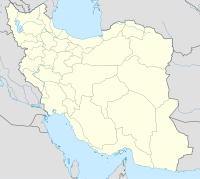Konar Sandal
28°26′59″N 57°46′42″E / 28.4496°N 57.7782°E
Konar Sandal | |
|---|---|
 Konar Sandal B | |
| Coordinates: 28°26′57.74″N 57°46′42.32″E / 28.4493722°N 57.7784222°E |
Konar Sandal is a Bronze Age archaeological site, situated in the valley of the Halil River just south of Jiroft, Kermān Province, Iran.
Description
[edit]The site consists of two mounds a few kilometers apart, called Konar Sandal A and B with a height of 13 and 21 meters, respectively. At Konar Sandal B, a two-story, windowed citadel with a base of close to 13.5 hectares was found. In 2005 a brick (or large tablet) fragment (text E') containing a short (about 5 symbols) inscription which appeared to be Linear Elamite was found in a secondary but defined context. In 2006 four baked (found associated with a kiln) tablets (texts B', C', and D') were found (one turned in by a villager and the others subsequently excavated in the area pointed out by the villager). Three tablets have what appears to be Linear Elamite on one side and symbols of unknown nature on the other. The fourth has only unknown symbols.[1] There has been speculation about the unknown symbols, called "Geometric script" by the excavator, ranging decorative gibberish to musical symbols. There has been controversy as well about whether the tables themselves are forgeries.[2][3][4]
Near Konar there are several other ancient sites from the same time period such as Hajjiabad-Varamin, the graveyards located at Mahtoutabad, and the mounds of Qaleh Koutchek.[5][6]
Jiroft culture
[edit]
The site is associated with the hypothesized "Jiroft culture", a 3rd millennium BC culture postulated on the basis of a collection of artifacts confiscated in 2001,[7] criticized for conjecture about material not found in secure archaeological contexts and probably including forgeries.[8] So the excavation of Konar Sandal is important in discovering artefacts in context.
Yousef Majidzadeh, head of the archaeological excavation team in Konar Sandal which began work after the 2001 confiscation, has identified the site as an "independent Bronze Age civilization with its own architecture and language".[9] Majidzadeh suggests they may be the remains of the lost Aratta Kingdom. Other conjectures (e.g. Daniel T. Potts, Piotr Steinkeller) have connected the site with the obscure city-state of Marhashi.
A 2013 research paper about the South mound states that excavations during 2006 to 2009 "revealed the remains of three successive settlements dating to the fourth millennium BC".[5]
Excavation re-commenced in 2014 and revealed art works of "complexity and beauty" and artifacts that proved that the society had several writing systems. According to National Geographic, the content of the mounds is significant:[10]
They turned out to contain the remains of two major architectural complexes. The northern mound included a cult building, while in the southern one were the remains of a fortified citadel. At the foot of the mounds, buried under many feet of sediment, were the remains of smaller buildings. It's believed that the two mounds had once formed part of a unified urban settlement that stretched many miles across the plateau" ... [artifacts] "have been dated to between 2500 and 2200 B.C. [They are said to be evidence of] the "development of a complex civilization".
References
[edit]- ^ Madjidzadeh, Y., "Jiroft tablets and the origin of the linear Elamite writing system", in: T. Osada/M. Witzel (ed.), Cultural relations between the Indus and the Iranian plateau during the third millennium BCE. Indus project, Institute for humanities and nature, June 7–8, 2008. Harvard oriental series, opera minora 7, Cambridge, pp. 217–243, 2011
- ^ Andrew Lawler, "Ancient Writing or Modern Fakery?", Science, Vol. 317. no. 5838, pp. 588–589, 3 August 2007
- ^ [1]Desset, François, "A new writing system discovered in 3rd millennium bce Iran: the Konar Sandal 'geometric' tablets", Iranica Antiqua, pp. 83-109, 2014
- ^ Kervran, Matthieu, "The Konar Sandal' Geometric' inscriptions: a graphotactic analysis", 2017
- ^ a b [2]Eskandari, Nasir, et al., "Preliminary report on the survey of Hajjiabad-Varamin, a site of the Konar Sandal settlement network (Jiroft, Kerman, Iran)", Iran, pp. 1-28, 2021
- ^ [3]Vidale, Massimo, and François Desset, "Mahtoutabad I (Konar Sandal South, Jiroft): Preliminary evidence of occupation of a Halil Rud site in the early fourth millennium BC", in Ancient Iran and Its Neighbours : Local Developments and Long-range Interactions in the 4th Millennium BC, Oxbow Books2013
- ^ Yousef Madjidzadeh, Jiroft: The Earliest Oriental Civilization (Tehran 2003),
- ^ O. W. Muscarella, Jiroft and "Jiroft-Aratta" A Review Article of Yousef Madjidzadeh, Jiroft: The Earliest Oriental Civilization, Bulletin of the Asian Institute, 15 (2005) 173-198: [4]
- ^ Madjidzadeh Y. and Pittman H. 2008 – Excavations at Konar Sandal in the Region of Jiroft in the Halil Basin: First Preliminary Report (2002-2008). Iran 46: 69-103.
- ^ "Buried for 4,000 years, this ancient culture could expand the 'Cradle of Civilization'". NGS. 25 February 2021. Retrieved 26 February 2021.
Further reading
[edit]- Nasir Eskandari; Massimo Vidale (22 October 2020). "Jiroft Civilization: Based on the Cuneiform Texts and Archaeological Evidences from Varamin and Konar Sandal". Alzahra. 30 (47): 11–29. doi:10.22051/hii.2020.31042.2234. Archived from the original on 14 March 2022. Retrieved 15 March 2022.
- Elisa Cortesi, Maurizio Tosi, Alessandra Lazzari, Massimo Vidale (2008), Cultural Relationships beyond the Iranian Plateau: The Helmand Civilization, Baluchistan and the Indus Valley in the 3rd Millennium BCE. Paléorient 34(2):5-35, doi:10.2307/41496521

